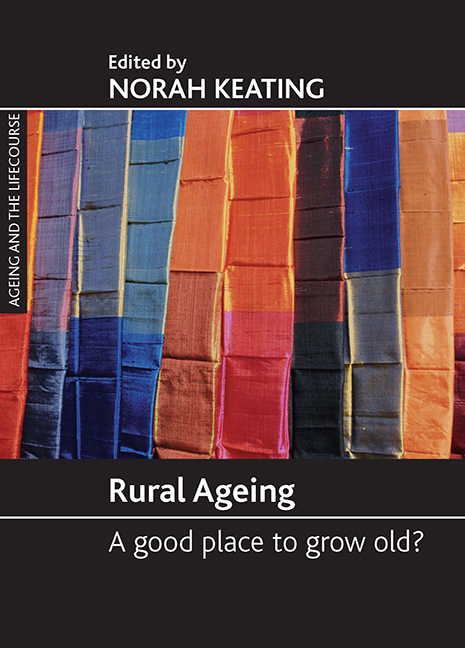Book contents
- Frontmatter
- Contents
- Foreword
- Acknowledgements
- Notes on contributors
- one A critical human ecology perspective on rural ageing
- two Crossing borders: lifecourse, rural ageing and disability
- three Rurality and ageing well: ‘a long time here’
- four The evolution of networks of rural older adults
- five Distance, privacy and independence: rural homecare
- six Respite for rural and remote caregivers
- seven Ageing, disability and participation
- eight Participation in rural contexts: community matters
- nine Staying connected: issues of mobility of older rural adults
- ten Ageing and social exclusion in rural communities
- eleven Age-friendly rural communities
- twelve Revisiting rural ageing
- References
- Index
- Other titles in the Ageing and the Lifecourse series
eleven - Age-friendly rural communities
Published online by Cambridge University Press: 19 January 2022
- Frontmatter
- Contents
- Foreword
- Acknowledgements
- Notes on contributors
- one A critical human ecology perspective on rural ageing
- two Crossing borders: lifecourse, rural ageing and disability
- three Rurality and ageing well: ‘a long time here’
- four The evolution of networks of rural older adults
- five Distance, privacy and independence: rural homecare
- six Respite for rural and remote caregivers
- seven Ageing, disability and participation
- eight Participation in rural contexts: community matters
- nine Staying connected: issues of mobility of older rural adults
- ten Ageing and social exclusion in rural communities
- eleven Age-friendly rural communities
- twelve Revisiting rural ageing
- References
- Index
- Other titles in the Ageing and the Lifecourse series
Summary
Introduction
Much concern has been expressed about the demographic changes that are the hallmark of population ageing. Projections of rapidly increasing numbers of older adults have led to a great deal of discussion in policy and practice communities about the kinds of services and support that they might require. At times, the discussion has taken on the tone of ‘apocalyptic demography’ (Gee, 2000, p 5) with older adults seen as a drain on public programmes and service infrastructure. In this context, rural areas have been viewed with apprehension since their populations are ageing more quickly than those in cities (Wagner, 2006).
Recently, there has been a shift in the discourse about population ageing away from problematising ageing towards an interest in creating settings in which older adults can flourish. The United Nations emphasises supportive environments in its International Plan of Action on Ageing: neighbourhoods and communities that ‘enable elderly people to continue to live, if they so wish, in locations that are familiar to them, where their involvement in the community may be longstanding and where they will have the opportunity to lead a rich, normal, and secure life’ (UN, 2003, p 12). There is increased interest in communities as providers of these supportive environments, and in how community settings create contexts in which older adults are able to flourish (Wahl and Weisman, 2003; Bronstein et al, 2006). International organisations have begun to articulate the ways in which communities might enhance the lives of older adults. The World Health Organization (WHO) (2006) has coined the term ‘age-friendly’ as a descriptor of such communities. Age-friendly communities are described as having policies, services and structures related to the natural, human-built and social environments that enable older people to ‘live in security, enjoy good health and continue to participate fully in society’ (WHO, 2006, p 1). WHO describes the main elements of age-friendly communities as the recognition of diversity among older adults, promotion of inclusion and contribution, respect for decisions and lifestyle choices and responsiveness to age-related needs and preferences.
In July 2006, WHO initiated the Global Age-Friendly Cities project to encourage countries across the world to enhance the environmental and social factors that contribute to healthy ageing in their cities. Concerns have also been expressed about rural areas where older adults may have access to lower levels of these resources (Bronstein et al, 2006; WHO, 2006).
- Type
- Chapter
- Information
- Rural AgeingA Good Place to Grow Old?, pp. 109 - 120Publisher: Bristol University PressPrint publication year: 2008



